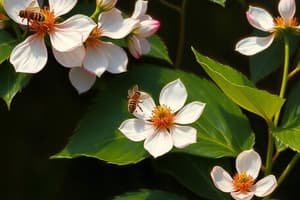Podcast
Questions and Answers
What is the function of sepals in a flower?
What is the function of sepals in a flower?
- To attract pollinators
- To store genetic material
- To produce pollen
- To protect the reproductive organs (correct)
Which plant reproduction method ensures genetically identical offspring?
Which plant reproduction method ensures genetically identical offspring?
- Pollination
- Grafting
- Layering (correct)
- Fertilization
How does asexual reproduction differ from sexual reproduction in plants?
How does asexual reproduction differ from sexual reproduction in plants?
- Sexual reproduction results in genetically identical offspring.
- Asexual reproduction requires two parents.
- Asexual reproduction involves genetic recombination.
- Sexual reproduction produces offspring with genetic variation. (correct)
What is the purpose of grafting in horticulture?
What is the purpose of grafting in horticulture?
Which plant parts are joined together in the process of grafting?
Which plant parts are joined together in the process of grafting?
What is the primary role of pollinators like bees, butterflies, and moths in plant reproduction?
What is the primary role of pollinators like bees, butterflies, and moths in plant reproduction?
Which type of plants primarily rely on wind for pollination?
Which type of plants primarily rely on wind for pollination?
What happens during fertilization in plants?
What happens during fertilization in plants?
Which process leads to the development of an embryo and a seed within the ovule?
Which process leads to the development of an embryo and a seed within the ovule?
In the context of plant reproduction, what is the primary function of flowering plants?
In the context of plant reproduction, what is the primary function of flowering plants?
Flashcards are hidden until you start studying
Study Notes
Plant Reproduction: A Guide to Pollination, Fertilization, Flowering Plants, and More
Plants, being stationary organisms, contribute to their survival and diversification through a process known as reproduction. This article will explore the fundamental aspects of plant reproduction, including pollination, fertilization, flowering plants, asexual reproduction, and grafting.
Pollination
Pollination is the transfer of pollen from the male parts of a flower (anther) to the female parts (stigma) of the same or another flower, leading to fertilization. Pollinators, such as insects, birds, mammals, and wind, help facilitate this process. Insect pollination is the most common, with bees, butterflies, and moths playing vital roles. Other animals, like hummingbirds, bats, and even some small mammals like shrews, also contribute to pollination. Wind-pollinated plants, like grasses and some trees, rely on airborne pollen for reproduction.
Fertilization
Fertilization in plants occurs when pollen released from the anther finds its way to the stigma. The pollen grain germinates, sending a tube down the style and into the ovary, where it fuses with the egg cell (ovum) in the ovule. This fusion results in the development of an embryo and a seed within the ovule, which eventually matures into a new plant.
Flowering Plants
Flowering plants constitute the majority of plant species, with their primary function being reproduction. Flowers are highly specialized reproductive structures that produce both male (pollen) and female (eggs) reproductive organs. The arrangement of flower parts in the form of sepals, petals, stamens, and carpels allows for efficient pollination and fertilization.
Asexual Reproduction
Asexual reproduction is a method by which a new organism is produced from a single parent without genetic recombination. In plants, this process occurs through vegetative propagation, including methods like cuttings, layering, grafting, and division. Asexual reproduction in plants is advantageous because it produces genetically identical offspring, ensuring that desirable traits of the parent plant are maintained.
Grafting
Grafting is a horticultural technique in which two genetically distinct plant parts (scion and rootstock) are joined together to create a single plant. Grafting is frequently used to improve the vigor, productivity, or disease resistance of plants. For example, the use of rootstock resistant to root diseases can help ensure the survival and success of a plant prone to disease.
Conclusion
Plant reproduction is a fascinating process that ensures the survival and diversification of plant species. Pollination and fertilization are essential for the development of new plants, while flowering plants are the primary vehicles for these processes. Asexual reproduction and grafting are additional methods for plant reproduction, offering advantages in specific scenarios. Understanding these fundamental aspects of plant reproduction will enhance your appreciation for the natural world and the role plants play within it.
Studying That Suits You
Use AI to generate personalized quizzes and flashcards to suit your learning preferences.




